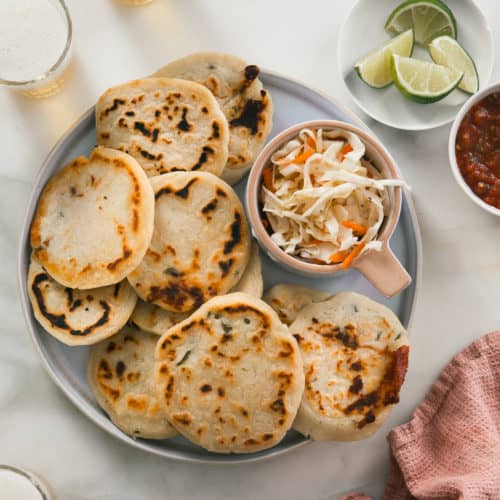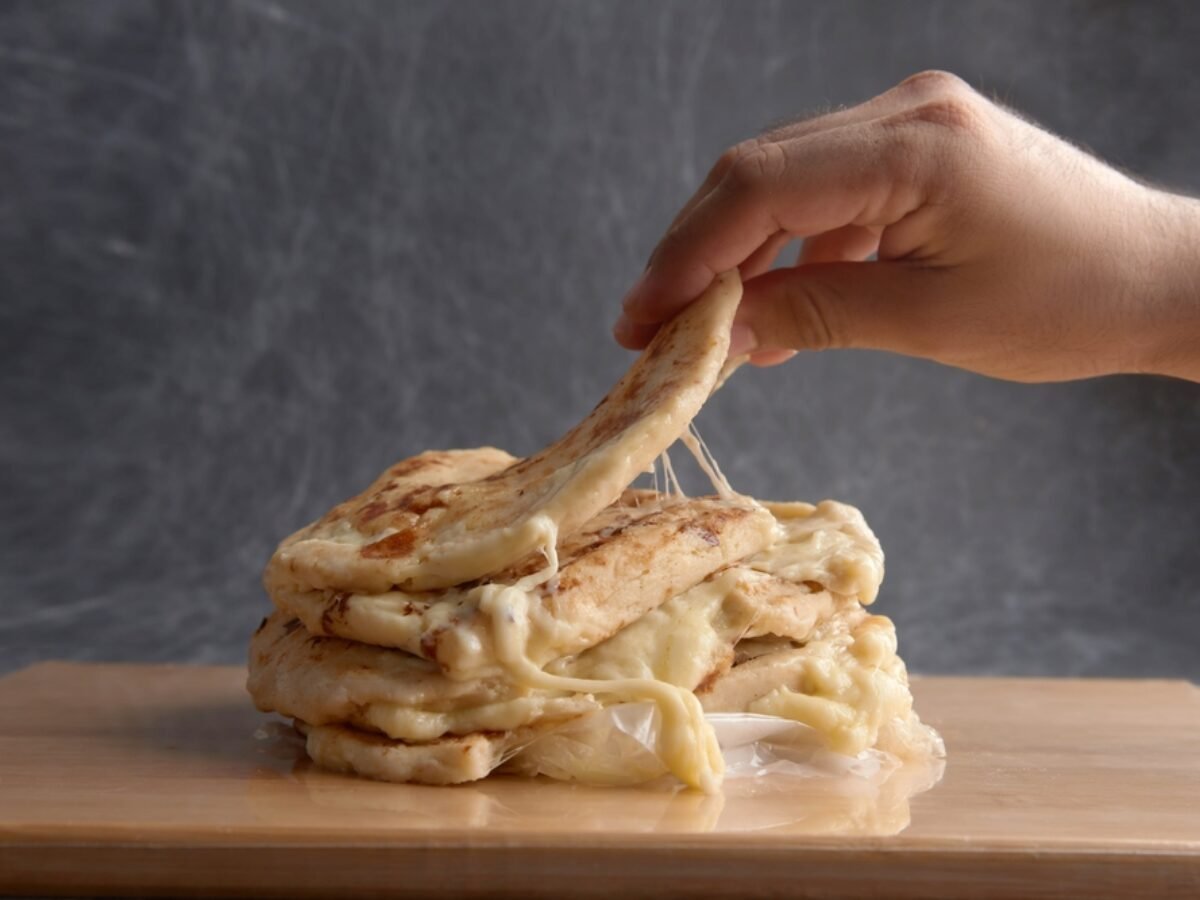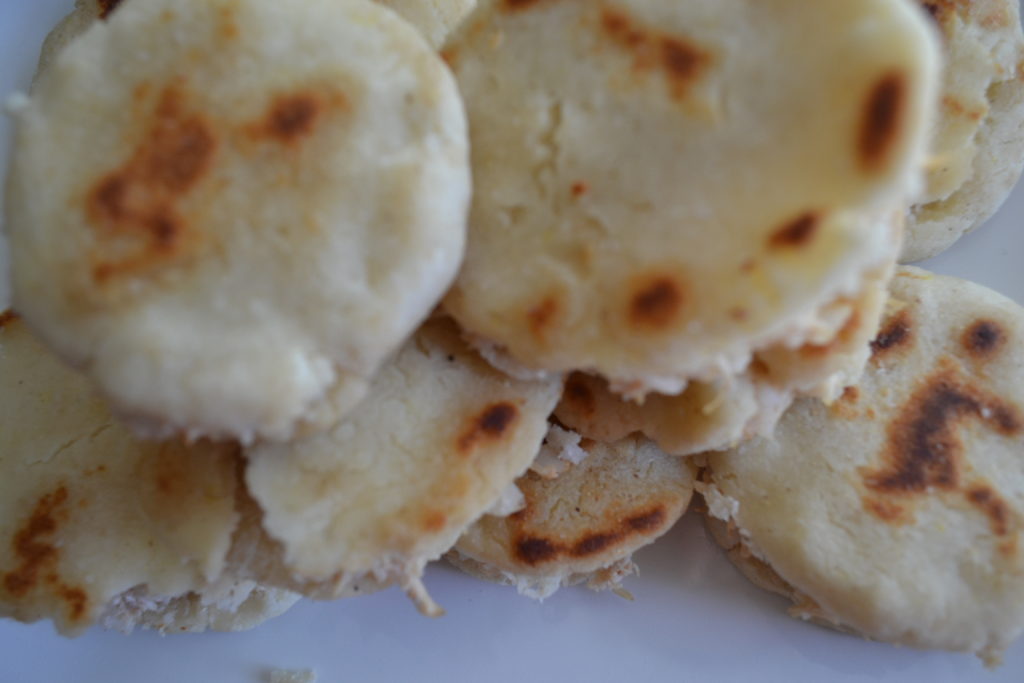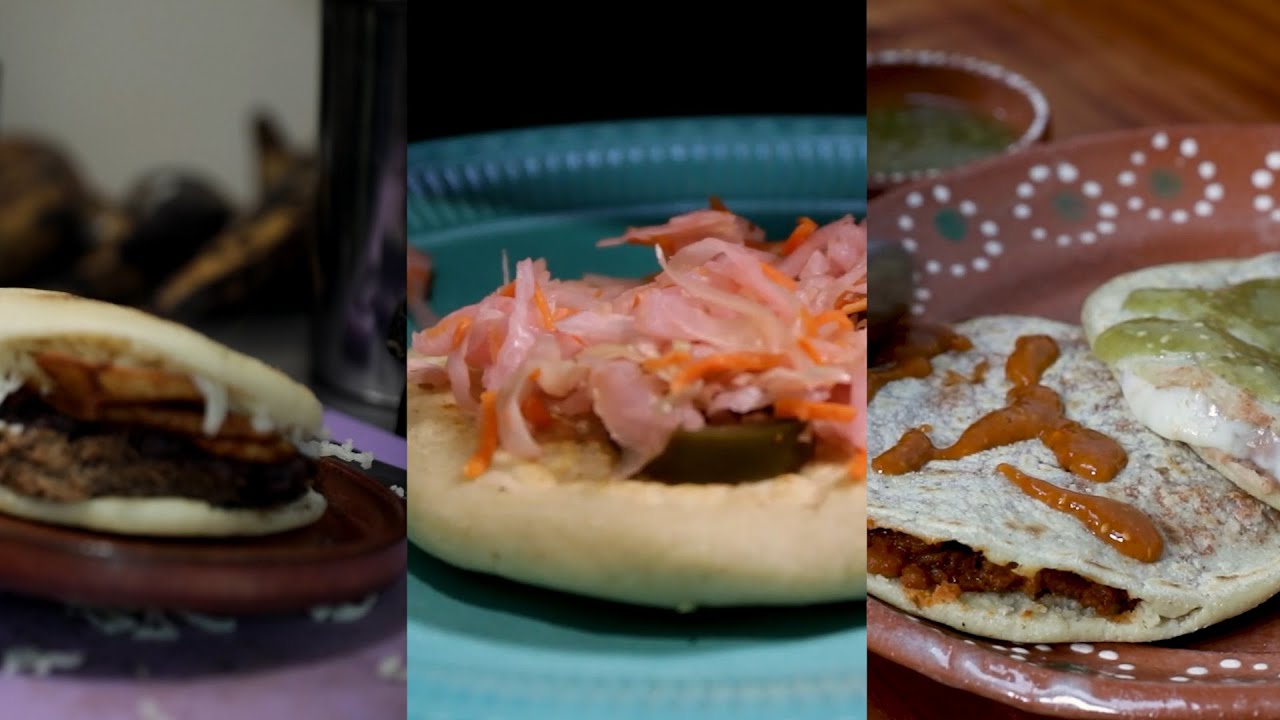Introduction To Pupusas And Arepas

Pupusas and Arepas are both beloved Latin American dishes that have gained recognition and popularity around the world. Pupusas originate from El Salvador and are essentially thick, handmade corn tortillas filled with various ingredients such as cheese, beans, or meat. Arepas, on the other hand, are a staple in Venezuelan and Colombian cuisine and are made from corn dough that is formed into a patty and cooked on a griddle. These two dishes not only showcase the culinary diversity of Latin America but also provide a delicious and satisfying experience for food lovers everywhere.
History And Origin Of Pupusas
Pupusas have a rich history that dates back to pre-Columbian times in El Salvador. The word “pupusa” is believed to come from the indigenous Pipil language, and the dish itself was a staple of the Pipil people’s diet. Originally, pupusas were made with simple ingredients like maize dough, called masa, and filled with beans or cheese. Over time, the dish evolved to include a variety of fillings, such as meat, vegetables, or even seafood. Pupusas are not only a delicious culinary tradition but also a symbol of the cultural heritage and resilience of the Salvadoran people.
History And Origin Of Arepas
The history of arepas can be traced back to indigenous tribes in what is now Colombia and Venezuela. These tribes relied on maize as a staple food, and they would grind the corn kernels into a fine flour or meal. This cornmeal dough was then cooked on hot stones or clay griddles, resulting in a flatbread known as “arepa.” The arepa has evolved over time, with different regions adding their own unique fillings and flavors. Today, arepas are enjoyed throughout Colombia and Venezuela and are a beloved part of the culinary heritage of both countries.
Pupusas: El Salvador’s Favorite Dish

El Salvador is known for its beloved dish, pupusas. Considered the national dish of the country, pupusas are a favorite among locals and visitors alike. These delicious stuffed cornmeal pancakes are filled with a variety of ingredients, such as cheese, beans, pork, or vegetables, and then grilled to perfection. The crispy exterior and gooey filling make pupusas a delight to bite into. They are typically served with curtido, a fermented cabbage slaw, and salsa. Pupusas are not only a delicious meal but also a symbol of El Salvador’s rich culinary heritage and a must-try for any food enthusiast.
Pupusas Ingredients And Filling Variations
Pupusas are made with a simple dough consisting of masa harina (corn flour mixed with water) and a pinch of salt. However, the true magic of pupusas lies in their filling variations. The most popular filling is the combination of cheese, beans, and pork, known as “revueltas.” Other delicious fillings include loroco (an edible flower bud), chicharrón (fried pork rinds), and vegetables such as zucchini or spinach. Each filling option adds its own unique flavor and texture to the pupusa, creating a delightful culinary experience. Whether you prefer a classic revuelta or are adventurous with your fillings, pupusas offer a satisfying and versatile meal option.
Pupusas Traditional Cooking Methods
Pupusas are traditionally cooked on a hot griddle or comal, which is a flat, round cooking surface made of cast iron or clay. The dough is shaped into a thick, round disk and then placed on the hot surface, where it is cooked until golden and slightly crispy on the outside. The pupusas are typically flipped once to ensure even cooking on both sides. This traditional cooking method allows the pupusas to develop a deliciously crispy exterior while maintaining a soft and doughy interior. The result is a perfect combination of textures that make pupusas a beloved and satisfying dish.
Arepas: Venezuela And Colombia’s Staple Food

Arepas are a staple food in both Venezuela and Colombia, where they are deeply rooted in the culinary traditions of these countries. In Venezuela, arepas are considered a national dish and are often enjoyed as a breakfast food or a snack throughout the day. They are incredibly versatile and can be filled with a variety of ingredients such as cheese, meat, beans, or even avocado. In Colombia, arepas are also a beloved food and are a common part of daily meals. They are typically made with white cornmeal and can be found in different shapes and sizes, depending on the region.
Arepas Ingredients And Regional Variations
Arepas are typically made with cornmeal, water, and salt, creating a dough that is then shaped into patties. However, the ingredients and regional variations of arepas can vary. In Venezuela, arepas are commonly filled with ingredients such as shredded beef, cheese, beans, or avocado. In Colombia, arepas are often stuffed with cheese, hogao (a tomato and onion sauce), or chorizo. Variations can also be found in different regions of both countries, with unique fillings and flavors that reflect the local culinary traditions. Whether it’s the traditional fillings or the regional twists, arepas never fail to satisfy hungry diners with their delicious combinations of flavors.
Arepas Preparation Techniques
Arepas are typically made by combining cornmeal, water, and salt to create a dough, which is then shaped into patties. The patties are then cooked on a griddle, in an oven, or fried until they are golden brown and crispy on the outside. The cooking method can vary depending on personal preference and regional traditions. Some people prefer to cook their arepas on a griddle or flat pan, while others prefer the deep-fried method for a crispier texture. Regardless of the cooking method, the end result is a delightful dish with a crispy exterior and a soft, doughy interior, ready to be filled with a variety of delicious ingredients.
Pupusas Vs Arepas: Flavor And Texture

When it comes to flavor and texture, Pupusas and Arepas have distinct characteristics that set them apart. Pupusas are known for their savory and tangy taste, thanks to the filling made from ingredients like cheese, beans, and meat, combined with a sprinkling of herbs and spices. The combination of the flavorful filling and the soft, doughy exterior creates a delightful contrast in each bite. On the other hand, Arepas have a mild and slightly sweet taste, allowing the fillings to take center stage. The texture of Pupusas is typically thicker and denser, while Arepas have a crispier and more firm texture due to the cooking method. Both dishes offer a unique and enjoyable eating experience, catering to different flavor and texture preferences.
A Comparison Of Pupusas And Arepas Taste Profiles
Pupusas and Arepas offer distinct taste profiles that showcase the unique flavors of Latin American cuisine. Pupusas are known for their savory and tangy taste, thanks to the flavorful fillings made from ingredients like cheese, beans, and meat, combined with a sprinkling of herbs and spices. Each bite of a pupusa provides a burst of flavor that is hearty and satisfying. On the other hand, Arepas have a mild and slightly sweet taste, allowing the fillings to take center stage. The combination of the crispy, golden exterior and the flavorful fillings creates a harmonious balance of flavors. Whether you prefer the tanginess of pupusas or the mildness of arepas, both dishes are sure to tantalize your taste buds and leave you craving for more.
Texture Differences Between Pupusas And Arepas
The texture of Pupusas and Arepas sets them apart from each other. Pupusas have a thicker and denser texture due to the masa harina dough used to make them. The filling inside adds a moist and gooey element, creating a delightful contrast with the crispy exterior. On the other hand, Arepas have a softer texture, similar to a thick pancake. They are slightly crispy on the outside but remain light and fluffy on the inside. The dough used for Arepas is more finely ground, resulting in a smoother and less grainy texture compared to Pupusas. Whether you prefer a heartier bite or a softer, pillowy texture, both Pupusas and Arepas offer a delightful culinary experience.
Cultural Significance Of Pupusas And Arepas

Pupusas and Arepas hold great cultural significance in the countries where they originated. In El Salvador, pupusas are not just a delicious dish but an integral part of the national identity. They are often prepared and enjoyed in social gatherings, family reunions, and festivals, showcasing the country’s rich culinary heritage. Similarly, in Venezuela and Colombia, Arepas are seen as a symbol of national pride and are enjoyed as a staple food in everyday life. These dishes reflect the traditions, flavors, and history of their respective cultures, bringing people together through their shared love for authentic Latin American cuisine.
Pupusas And Arepas In Latin American Celebrations And Festivals
Pupusas and Arepas play a significant role in Latin American celebrations and festivals, adding a delicious touch to these joyous occasions. In El Salvador, pupusas take center stage during festivities like the Fiesta de la Flor, where they are enjoyed by locals and tourists alike. Similarly, in Venezuela and Colombia, Arepas are a staple at cultural events such as the Feria de San Juan or the Carnaval de Barranquilla. These dishes bring people together, creating a sense of community and shared cultural heritage. Whether it’s a small gathering or a large-scale celebration, Pupusas and Arepas bring joy and flavor to every occasion.
Symbolism And Traditions Associated With Pupusas And Arepas
Pupusas and Arepas hold significant symbolism and traditions in Latin American culture. These beloved dishes often represent community, family, and the celebration of heritage. In many Latin American households, making pupusas and arepas is a family affair, passed down from generation to generation. The process of kneading the dough and shaping it into perfect discs embodies the connection between family members, as they gather around the kitchen table to create these delicious treats. Pupusas and arepas are also part of special occasions and celebrations, where they serve as a symbol of unity and pride in Latin American traditions. They are often enjoyed with loved ones, showcasing the importance of community and togetherness. Whether it’s a small gathering or a large-scale festival, pupusas and arepas bring people together and create lasting memories.
Conclusion

In conclusion, Pupusas and Arepas are both beloved Latin American dishes that showcase the rich culinary heritage of El Salvador, Venezuela, and Colombia. While Pupusas are a favorite in El Salvador with their thick and stuffed corn tortillas, Arepas are a staple in Venezuelan and Colombian cuisine with their versatile filling options. Both dishes offer a unique combination of flavors and textures that are sure to satisfy any palate. Whether you prefer the comforting and cheesy Pupusas or the crispy and versatile Arepas, one thing is certain – the cultural significance and taste of these culinary delights will leave you wanting more. So, next time you have the opportunity, don’t miss the chance to try both Pupusas and Arepas and experience the flavors of Latin America.
Key Differences Between Pupusas And Arepas
Pupusas and Arepas may share similar cooking methods and ingredients, but there are key differences that set them apart. Firstly, the dough used in Pupusas is made from a combination of cornmeal and water, while Arepas use pre-cooked cornmeal known as masarepa. Additionally, Pupusas are typically stuffed with a variety of fillings such as cheese, beans, or meat, while Arepas can be either stuffed or topped with various ingredients. Lastly, Pupusas are thick and flat, resembling tortillas, while Arepas are thicker with a crispy exterior. These differences contribute to the unique flavors and textures of each dish.
Personal Preferences And Culinary Experiences With Pupusas And Arepas.
When it comes to personal preferences and culinary experiences, Pupusas and Arepas offer a delightful journey for the taste buds. Some people may prefer the rich and savory fillings of Pupusas, such as cheese, beans, or meat, which provide a burst of flavors in every bite. On the other hand, Arepas offer a versatile canvas for various toppings, allowing individuals to customize their culinary experience with ingredients like shredded meat, avocado, or cheese. The crispy exterior of Arepas adds a satisfying crunch to the overall texture. Ultimately, personal preferences may vary, but both Pupusas and Arepas guarantee a mouthwatering and memorable gastronomic experience.
FAQ About Pupusas Vs Arepas: Latin American Culinary Delights Compared
Q: What are pupusas and arepas?
A: Pupusas are traditional Salvadoran thick corn tortillas stuffed with various fillings like cheese, beans, or meat. Arepas, on the other hand, are round corn cakes from Colombia and Venezuela made with cornmeal or maize flour.
Q: How are pupusas and arepas different?
A: Pupusas are thicker and stuffed with fillings, while arepas are thinner and usually served plain or with toppings.
Q: What are the typical fillings for pupusas?
A: Common pupusa fillings include cheese (queso), refried beans (frijoles refritos), and shredded pork (chicharrón).
Q: How are arepas usually served?
A: Arepas are commonly split open and filled with various ingredients such as cheese, avocado, meats, or eggs to create a sandwich-like meal.
Q: Are pupusas and arepas gluten-free?
A: Pupusas are typically gluten-free as they are made from corn masa. Arepas can also be gluten-free depending on the type of corn flour used.
Q: Which countries are pupusas and arepas popular in?
A: Pupusas are popular in El Salvador, while arepas are staples in Colombia and Venezuela. Both dishes have gained popularity across Latin America and beyond.

The Bird ‘n’ Bike Cafe ‘n’ Bar is a charming establishment nestled in the heart of Chiltern, Victoria, where locals and visitors alike come together to enjoy delicious food, great company, and a warm, welcoming atmosphere. With 1187 likes and 136 check-ins, it’s clear that the Bird ‘n’ Bike has captured the hearts of many. Our cafe and Bar is open from Wednesday to Sunday, inviting guests to start their day with us from 8 am to 2:30 pm. Whether you prefer to dine in and savor the cozy ambiance or grab a delicious meal, we’ve got you covered.